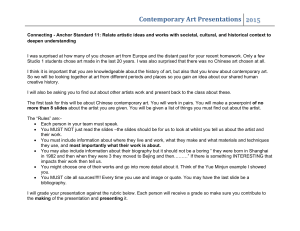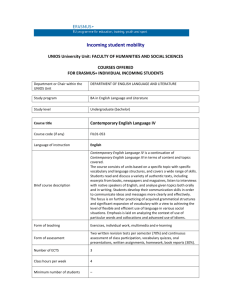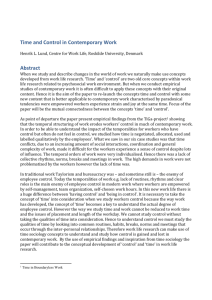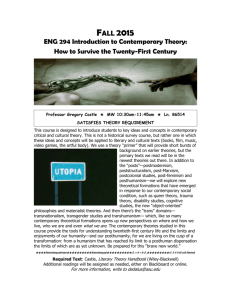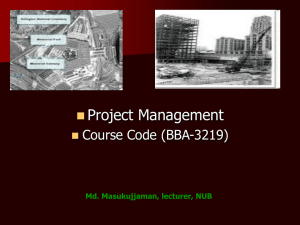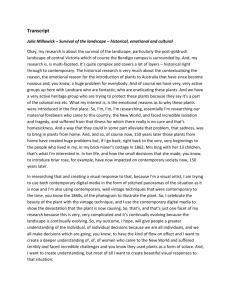Contemporary Art Lesson Plans - UCF College of Education and
advertisement
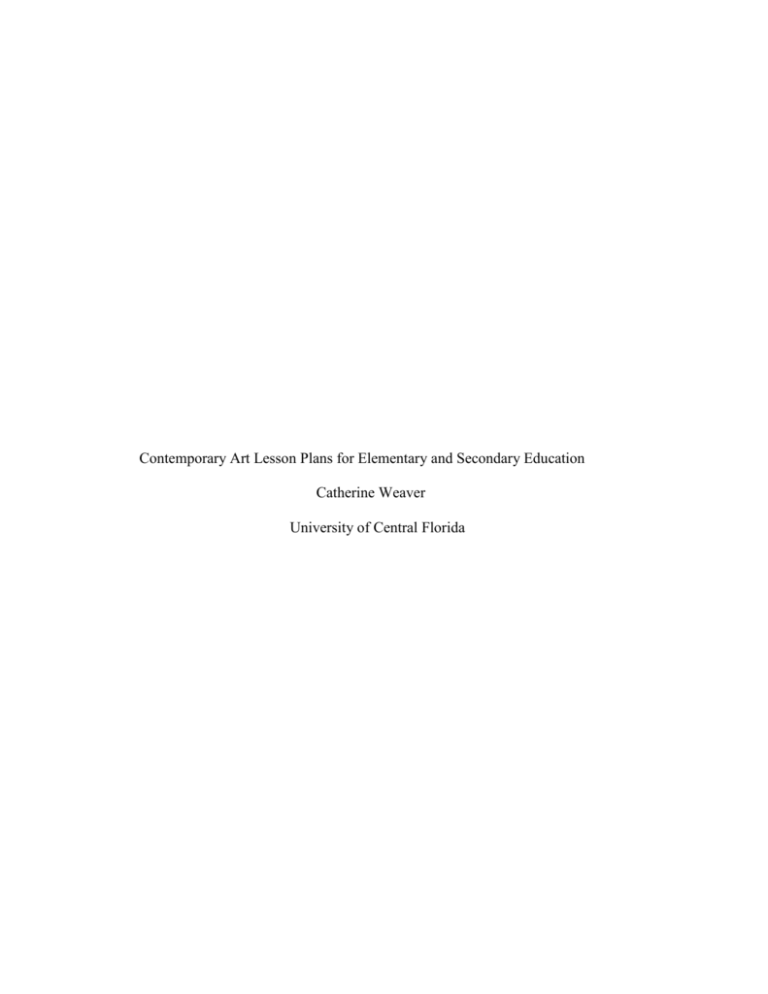
Contemporary Art Lesson Plans for Elementary and Secondary Education Catherine Weaver University of Central Florida Contemporary Art Lesson Plans 2 Elementary 2D Lesson Plan Alyne Harris, n.d., Cotton Field Alyne Harris, n.d., Slave Women Big Ideas Historical and Global Connections Skills, Techniques, and Processes Objective For this lesson, I would like students to be able to identify historical events and issues about slavery that may have been influential in their own history and family past. I would also like for them to look at these images and paint from these works their own life experiences by using color, form, and line. By showing them these historical images and allowing them to draw from them by expressing their own experiences, I am allowing them to connect the visual arts with other disciplines. This shows them that art is more than creating pretty pictures. Art can hold meaning and draw from what they know and as well as what inspires them. Procedures Alyne Harris is a Florida Folk Artist from Gainesville, Florida. Her work depicts scenes from church, black history, nature, and memories from her childhood. She uses her hands, Contemporary Art Lesson Plans 3 brushes, sticks, kitchen utensils, and anything else available to her to paint her images onto canvas using acrylic paint. She began as a self taught artist and painted with mud at night while worked as a housekeeper during the day. I chose Harris for my lesson plan because she uses issues of black history to convey brightly colored scenes. By providing students with an understanding and a connection with historical and global issues, students are able to connect with historical events that may have affected their ancestors and family members. Students will identify examples of works created by artists that relate to cultural as well as life experiences. They will use these resources to inspire expression of personal ideas and experiences in the works of art they view in class. Based on what they have found, they will sketch a life experience that they wish to present to the class and then paint it with tempera paint. “Projects such as reconstructing memories of childhood….or describing how their identities are constructed in part by objects….often afford students unexpected insights into self” (Gude, 2007, pp.8). Assessment Materials include tempura paint, paint brushes, pencils for sketching what they want to draw, and paper For this assignment, I want students to learn how history has made an impact on their lives in some way or another as well as provide them with the basic art making skills of drawing with line, color, and form. See assessment rubric in appendix Statement of Origin I came across the idea of using culture by viewing samples of folk art. I believe children can reflect on these images of slavery and learn that art can be representative of one’s past and Contemporary Art Lesson Plans 4 how they fit in with society. I believe that students need to be provided with a meaningful art experience which, according to Amy Giles is “an experience for which a child has intensity,…a disposition to lose oneself in an activity, and purpose,…to be a result or effect that is intended or desired” (Giles, 1999, pp.1). References Harris, A. (n.d.). Cotton Field. Retrieved from http://www.jtfolkart.com/artist/alyne-harris/. Harris, A. (n.d.). Slave Women. Retrieved from http://www.jtfolkart.com/artist/alyne-harris/. Giles, A. R. (1999). “School Art Versus Meaningful Artistically Authentic Art Education.” NAEA Advisory, Ed. Christine Davis, National Art Education Association, pp. 1-2. Gude, O. (2007). “Principles and Possibilities: Considerations for a 21st Century art and Culture Curriculum,” Art Education, Vol. 60, No. 1, pp. 6-17. Secondary 2D Lesson Plan Tom Feelings, 1995,from The Middle Passage Big Idea Critical Thinking and Reflection Tom Feelings,1995, from The Middle Passage Contemporary Art Lesson Plans 5 Skills, Techniques, and Processes Organizational Structure Historical and Global Connections Objectives For this lesson, I would like students to identify with a dehumanizing and devastating event from history such as in the images above with the slave trade. Students will reflect upon this historical event and think about how it may have affected them. Students will analyze the above drawings and overall structure of them and determine the overall composition. By evaluating this work, students will gain a perspective on what kind of environment these individuals had to deal with. Procedures Tom Feelings is an illustrator for many children books. His illustrations consist mainly of African American men and women. In The Middle Passage (1995), from which these images were obtained, his illustrations deal with slavery and the poor conditions brought upon to these men and women. "When I am asked what kind of work I do, my answer is that I am a storyteller, in picture form, who tries to reflect and interpret the lives and experiences of the people that gave me life” (Feelings, n.d.). For this lesson plan, students will review the historical event of the slave trade and how this may have had an effect on their upbringing. Students will analyze these drawings based on technical skills, development of idea, aesthetic appeal, and social implementation. They will also be asked to identify what form of perspective is shown in these images, the line quality and composition found in these images, and where the horizon line lays in each image. Then, students will convey their own historical rendition of the slave trade using the perspective that is Contemporary Art Lesson Plans 6 found in both of these images (one-point perspective) as well as drawing themselves into their image. By teaching students to “immerse themselves in a process of making and sensitively interact with images and ideas as they emerge” (Gude, 2007, pp.8), students will be able to identify with the work and form an intellectual and emotional reaction to their work as well as the historical event portrayed within the image. Assessment Materials include, pencil, charcoal, paper, erasers, and blending sticks. I believe it is important for students to know and understand events in history that have placed an impact on how the world is today. I also believe it is important for students to learn how to draw perspective using techniques that they will continue to use as they advance into the art making world. See assessment rubric in appendix Statement of Origin The idea of placing the students inside the historical event of the slave trade was brought about by Olivia Gude’s (2007) article, Principles of Possibility: Considerations for a 21st Century Art and Culture Curriculum. In this article, she expresses the importance of students being able to formulate an idea of self. She explains that “quality projects aid students in exploring how one’s sense of self is constructed within complex family, social, and media experiences” (Gude, 2007, pp. 8). By connecting Gude with an historical event and placing the student as the figure in the image as the victim of the piece, students are connecting with how it may have felt to be in that place at that time and therefore be able to empathize with individuals stuck in similar situations. References Contemporary Art Lesson Plans 7 Clark, J.H. (1995). The Middle Passage (T. Feelings, Illus.). Retrieved from http://www.juneteenth.com/middlep.htm. Clark, J.H. (1995). The Middle Passage (T. Feelings, Illus.). Retrieved from http://www.juneteenth.com/middlep.htm. Gude, O. (2007). “Principles and Possibilities: Considerations for a 21st Century art and Culture Curriculum,” Art Education, Vol. 60, No. 1, pp. 6-17. Feelings, T. (n.d.). Retrieved from http://www.juneteenth.com/Tom_Feelings.htm. Elementary 3D Willie Cole, 2008, Love Seat Big Idea Critical Thinking and Reflection Historical and Global Connections Innovation, Technology, and the Future Objectives During this lesson, I would like students to be able to learn about the artist that constructed these sculptures made out of shoes and for what purpose. I would like students to Contemporary Art Lesson Plans 8 reflect upon our own culture and how many items we throw away that could still be recycled and reused to construct forms such as these chairs. I want students to think about how they would create their own forms with reusable items Procedures Willie Cole is known for his transformations of ordinary, discarded domestic objects, such as shoes, irons, and lawn jockeys, into powerful works of art that present social, political or cultural perspectives of the urban African American experience.“Great art often engages the most significant issues of community, calling on each of us to bring our deepest understanding and empathy to our shared social experience” (Gude, 2007, pp. 8). Students should be engaged in what is going on in society and how to change the world to provide for a better future. In this lesson plan, students will construct sculptural forms out of an item they have found in multiple such as bottle caps, plastic bottles, buttons, etc. that can be constructed together to make a cohesive form. This lesson plan will reflect upon our culture’s wasteful abilities and how to make constructive, useful objects from these recyclable materials. During this exercise, students will gain an appreciation for our world and learn the importance of recycling as well as how to be resourceful with materials. Assessment Materials- Have students collect multiples of a single item, glue, string, thin wire, and anything that can be used to keep these items together. After this lesson is completed, students should be able to provide an understanding of culture based materials and have developed an appreciation for the environment. Students should learn to be resourceful with materials and should be able to construct aesthetically pleasing forms from recyclable materials. Contemporary Art Lesson Plans 9 See assessment rubric in appendix Statement of Origin Willie Cole’s use of everyday objects such as the shoe sculptures above inspired me to think of issues of recycling materials and using them to create works of art. By teaching kids to use their discarded materials in new ways such as making functional furniture, I am teaching students to be aware of materials and their worth rather than just throwing them out. At the same time, I am showing them how to create a cohesive, functional form using the idea of multiples. References Cole, W. (2008). Love Seat. Retrieved from http://collections.madmuseum.org/code/emuseum.asp?emu_action=searchrequest&modul eid=1&profile=objects&currentrecord=1&style=single&rawsearch=id/,/is/,/5476/,/false/,/ true. Cole, W. (1993). Made in the Philippines. Retrieved from http://www.artknowledgenews.com/2009-08-07-22-56-49-willie-cole-and-hank-willisthomas-explore-amistad-centers-extensive-collection-of-art.html. Gude, O. (2007). “Principles and Possibilities: Considerations for a 21st Century art and Culture Curriculum,” Art Education, Vol. 60, No. 1, pp. 6-17. Secondary 3D Lesson Plan Contemporary Art Lesson Plans 10 Lesley Dill, 2010, Heaven/Hell Dress Lesley Dill, 2010, Sister Gertrude Installation Big idea Critical Thinking and Reflection Skills, techniques, and Processes Organizational Structure Innovation, Technology, and the Future Objectives To show how text and artistic elements are interconnected. In this lesson, students will combine creative and technical knowledge to produce visually strong works of art. By using text in their scenes of duality, they are making connections between the art of written language and the act of making art itself. Combining these dual elements into one scene or image will allow for a more complex and graphically appealing scenario. Procedures Lesley Dill’s work deals primarily with themes of language, the body, emotion, and society. Dill describes language as being “the touchstone, the pivot point of all my work” (Hunter Museum of American Art, n.d.). Her use of language stems from a book of poetry by Contemporary Art Lesson Plans 11 Emily Dickenson that her mother gave her. She saw images in the words that she simply could not ignore. Dill describes words as her “spiritual armor” that she stitches and weaves across her multi-layered works. I chose Dill for my Secondary 3D lesson plan because I feel like her work speaks to students. She uses recognizable forms and places text on top of them to illustrate and convey her intended meaning behind her work. By doing this, she is construing multiple meanings to the viewer. Create a single sculpture that incorporates a conflict within your value system (can choose from provided list or create your own with permission from teacher): Heaven vs. Hell Good vs. Evil Appearance vs. Reality **Must use text to convey your message. Examples shown in the dresses above. Preliminary sketches will be made to tell whether the student is on the right track or not. These sketches will be peer reviewed and critiqued in class. The sculpture does not have to be something from real life. It can be imaginative or abstract in form. You can use your imagination to invent forms that may have been stimulated from real objects (Linderman, 1996, pp. 109). Assessment The materials used for this assignment will consist of making a wire amateur that shall be covered with papier-mâché (strips of newspaper dipped in papier-mâché) and painting with acrylic paint. Contemporary Art Lesson Plans 12 Students will have a basic understanding of how text can promote visual literacy and how to combine artistic forms with text to transform a simple idea into a complex message. Using scenes of duality allows for students to think critically, reflect, and present a message they wish to use to represent themselves. Also, by using new and unfamiliar processes of art making, students are able to form new art making abilities. See grading rubric in appendix Statement of Origin I originally thought about this idea of duality but I did not know how to make it into a concise lesson plan. At first, I thought about having students weave words into fabric, but I couldn’t figure out the purpose or what the end product’s meaning would be or represent. After looking at the images as not dresses, but instead as sculptural forms, I decided that students should create a single sculpture with both conflicting views embodied into it. References Dill, L. (2010). Heaven/Hell Dress. Retrieved from http://www.arthurrogergallery.com/dynamic/artist_pressrelease.asp?ArtistID=19. Dill, L.(2010). Sister Gertrude Installation. Retrieved from http://www.arthurrogergallery.com/dynamic/artwork_display.asp?ArtworkID=4710&Exh ibitID=166. Hunter Museum of American Art (n.d). I Heard A Voice: The Art of Lesley Dill. Retrieved from http://www.huntermuseum.org/exhibition/7/i-heard-a-voicethe-art-of-lesley-dill/. Linderman, M.G. (1996). “Chapter 8: Art Production: Ideas and Techniques,” Art in the Elementary School, McGraw Hill, pp. 108-112. Contemporary Art Lesson Plans 13 Elementary Media Criticism Carl Knickerbocker, n.d., They’re Putting TV in my brain Carl Knickerbocker, 2010, Evolution of Reedy Creek Big Idea Critical Thinking and Reflection Historical and Global Connections Objectives To provide students with an understanding of the media and how it shapes society’s values. Students will learn the importance of comparing and contrasting images of Florida throughout various historical periods. Additionally, students learn to create their own original artistic examples of how media shapes culture. Procedures Carl Knickerbocker is a University of Central Florida graduate whose work deals primarily with themes of Florida and the sociopolitical. He is self taught and uses colorful canvases to present his ideas and images to the viewer. Jeanine Taylor Folk Art expresses that Knickerbocker’s art can make you “think and laugh at the same time” (Jeanine Taylor Folk Art, 2011). Contemporary Art Lesson Plans 14 For this lesson, study both pictures. Do you happen to notice how something in each picture takes over something that was there before? For example, what might have been in the man’s head before it was replaced with the TV? What is the difference between the TV and a brain? In the second picture what was the land like in Florida before theme parks such as Disney replaced the natural landscape? What changes have occurred in both pictures? Can you think of something else that has happened in your surroundings and what effects did that have on you and the area you live in? Illustrate your idea through the medium of paint. A preliminary sketch will be made to make sure that you are on the right track. Assessment Materials include tempura paint, paper, brushes, and paper and pencil to sketch their preliminary idea. Students will be asked the above questions and will use critical thinking skills in a group setting to analyze how something is affected when an object or item is bestowed upon and replaces what was once there. Grading for this assignment will be assessed in two parts. The group discussion section will address how well they understand the topic as well as whether they provided any of their own input and thoughts into the conversation. The painting will be assessed using the appropriate grading rubric found in the appendix as well as how well they understood the project and what was asked of them. Statement of Origin I was looking at these images, trying to figure out what they had in common and how to create a lesson plan that would provide students with a critic on the media as well as be simple enough for students to comprehend and understand. I realized that in each of these images, Contemporary Art Lesson Plans 15 something is being replaced. I then came across the idea of having students think about what it is that is being replaced and reflect upon what has been replaced or changed in their own lives. The final project will reflect the knowledge they have gained during the group discussion. References Jeanine Taylor Folk Art. (2011). Retrieved from http://www.jtfolkart.com/product//theyreputting-tv-in-my-brain/. Knickerbocker, C. (n.d.). They’re Putting TV in My Brain. Retrieved from http://www.jtfolkart.com/product//theyre-putting-tv-in-my-brain/ Knickerbocker, C. (2010). Evolution of Reedy Creek. Retrieved from http://www.carlknickerbocker.com/ Secondary Media Criticism Hank Willis Thomas, 2008, Black Power Big Idea Critical Thinking and Reflection Historical and Global Connections Objectives Hank Willis Thomas, 2004, Afro-American AmEx Contemporary Art Lesson Plans 16 To inspire students to use critical thinking skills, reflect upon how media has had an effect on them as well as their personal ideas about society and other social conditions in the United States as well as other countries around the world. Procedures Hank Willis Thomas is a photo conceptual artist working primarily with themes related to identity, history and popular culture. His goal is to “employ the familiar or Roland Barthes whatgoes-without-saying, to draw connections and provoke conversations about issues and histories that are often forgotten or avoided in our commerce-infused daily lives" (Light Work, n.d.). I chose Thomas for my lesson plan because I believe he is able to express his main ideas for creating his work in simple, yet concise photographic images. Students can immediately identify with these images as well as look further and delve deeper into what they represent and communicate to the audience. In this lesson plan, students will use critical thinking skills to develop, refine, and reflect on Hank Willis Thomas’s theme. The students will write a response to the images they see above and how they interpret the meanings behind these pieces as well as how it affects them on a personal level. After writing what they think these images represent and reflecting upon them with personal experiences there will be an in class group discussion where each student will summarize what they thought the meaning represented and how it affected them personally. Then, students will create their own media criticism that has affected them on a person level through the medium of photography. They will each compose two images, one of which has to have them in the photo. This may allow them to better represent how they have been affected by the media. Contemporary Art Lesson Plans 17 Assessment Black or Blue pen, paper, a digital point and shoot camera, and photo paper (glossy, semi-glossy, luster, or matte finish). At the conclusion of this lesson, students will have thought critically about media criticism and how it has affected their lives in the social world. Students will also utilize the medium of photography to additionally prove what they have learned during this assignment and how they can apply media criticism in their own artwork. Students will be graded based on how well they interpreted the meanings of behind these works for the writing portion of this assignment as well as through the grading rubric for the photograph portion of the assignment. Participation during the in class discussion counts 1 points towards their final grade. See assessment rubric in appendix Statement of Origin As I read Thomas’s biography about his work, I considered the idea of having students reflect upon his work and the meanings behind them. I quoted him for saying that he hopes to promote discussion which is how I came across the idea of having students write a reflection and then have a group discussion on their ideas about the work. I then decided that more was needed for them to involve their own interpretation into the piece. I thought about one of my assignments from Dr. Hopp’s Classroom Management class where we were instructed to make two photographs, one of which had to include ourselves. I felt that this was beneficial to students because it forces them to include themselves and their own personal views into a work of art. References Thomas, H.W. (2008). Black Power. Retrieved from http://www.aperture.org/exposures/?p=257 Contemporary Art Lesson Plans 18 Thomas, H.W. (2004). Afro American AmEx. Pitch Blackness. Retrieved from http://hammer.ucla.edu/calendar/detail/year/2008/month/10/day/1/type/program/id/51. Thomas, H.W. (n.d.). Light Work. Retrieved from http://www.lightwork.org/store/thomas.html. Appendix Elementary Grading Rubric Students can receive a maximum of 100 points for an assignment. The total number of points corresponds to a letter grade. Additional “bonus” points may be allotted according to conditions outlined below. Teachers comments: _____________________________________________________________________________________ _____________________________________________________________________________________ _____________________________________________________________________________________ _____________________________________________________________________________________ _____________________________________________________________________________________ Grading Scale A = 90-100 B = 80-89 C =70-79 D = 60-69 F = below 59 Contemporary Art Lesson Plans 19 Secondary Grading Rubric Students can receive a maximum of 100 points for an assignment. The total number of points corresponds to a letter grade. Additional “bonus” points may be allotted according to conditions outlined below. Teachers comments: _____________________________________________________________________________________ _____________________________________________________________________________________ _____________________________________________________________________________________ _____________________________________________________________________________________ In-Class Discussion (+1 point) Student’s participation in group discussions following the completion of a lesson will count towards the final class grade. Students are adjudicated based on their ability to discuss and defend their work, and to constructively critique each other’s work: _____________________________________________________________________________________ _____________________________________________________________________________________ _____________________________________________________________________________________ _____________________________________________________________________________________ Grading Scale A = 90-100 B = 80-89 C =70-79 D = 60-69 F = below 59 Contemporary Art Lesson Plans 20 Elementary and Secondary Classroom Management Plan Objective To provide a safe environment in which students can access materials quickly and efficiently learn, work and create. Level of Teacher The teacher has authority over the classroom and is the facilitator while students work on their assignments. Learning Environment Providing students with a productive and safe environment helps conduct a better learning environment. The classroom should be a challenging environment that enables students to be engaged and be able to interact with each other respectfully and responsibly. Student’s needs should be met by allowing them to be comfortable, interested, motivated, inspired and engaged so that they are able to grow and learn. Floor Plan For the most efficient use of the classroom, its layout and resources, a modular layout is advised, in which students or instructors reorganize a room according to the requirements of the lesson. Materials are provided for each student at the beginning of class and are to be kept at their stations until the end of the period. Classroom Style 1: figure 1 This first layout can be viewed as the default-standard. Wide lanes between desks allow the instructor full and easy access to each desk. The desks face the front of the room, where the instructor provides information, gives presentations, and performs demonstrations. Policies: Rules and Expectations Contemporary Art Lesson Plans 21 Students must be: On Time and prepared. Respectful and attentive: o Raise your hand if you wish to speak; wait until you have been recognized and passed a special item (ball, piece of chalk, etc) before you speak. o No swearing, no rude remarks. Clean up after yourself. Demonstrations on proper cleaning and organizing methods will be given at the beginning of classes. Respect your supplies, materials, and equipment. Demonstrations on proper usage will be given at the beginning of each lesson. Respect others and their property. There are no circumstances under which it is acceptable to physically engage another individual, or their personal belongings, equipment, supplies, or projects without permission. No devices in class. This includes smart phones, music players, portable gaming consoles, etc. No food or drinks allowed in class. Elementary Consequences First Action: Public warning; student is addressed by name and instructed to curtail their disruptive behavior. Second Action: Student is assigned extra work as a punitive measure. Third Action: Student is removed from their assigned seat and isolated in an area where they are visible to students and the instructor. Fourth Action: Student is removed from class entirely. Asked to either proceed to the Administrator’s office or wait in the hall. *It should be noted that any in-class disruption will require a student to remain after class and speak privately with the instructor regarding their behavior. Secondary Consequences First Action: Public warning; student is addressed by name and instructed to curtail their disruptive behavior. Second Action: Student is assigned mathematics work as a punitive measure. Contemporary Art Lesson Plans 22 Third Action: Student is removed from their assigned seat and isolated in an area where they are visible to students and the instructor. Fourth Action: Student is removed from class entirely. Asked to either proceed to the Administrator’s office or wait in the hall. *It should be noted that any in-class disruption will require a student to remain after class and speak privately with the instructor regarding their behavior. ** Any serious abuses or violations of policies, including violations of academic honesty, will be dealt with according to each school’s proprietary Code of Student Conduct. Rewards For those abiding by the policy’s rules and expectations, rewards will be distributed as deemed appropriate by the teacher. This includes the ability to give or take away an end of the year art show that presents student work that has been made over the course of the year. School Policy Please comply with the school’s Code of Student Conduct. The code of student conduct is established to foster and protect the core missions of the school, to foster the development of the students in a safe and secure learning environment, and to protect the people, properties and processes that support the school and its missions.
